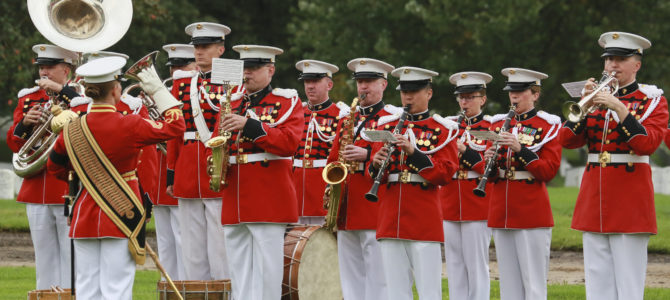
Armies have used music to rally troops in battle since biblical days. During the American War for Independence, boys too young and men too old to fight often played the fife and drum for the Continental Army, using music to signal commands as well as to boost soldiers’ morale.
A particular tune might direct troops to cease fire, or to reload their rifles. While music rarely has such a practical use on the battlefield today, each branch of the U.S. armed forces proudly maintains its own anthem. As Independence Day approaches, the fascinating stories behind each military anthem are worth knowing.
U.S. Army
The official song of the U.S. Army, “The Army Goes Rolling Along,” wasn’t officially adopted until 1956, but it was written in 1908 by an artilleryman in the Philippines. First Lt. Edmund Gruber (whose relative wrote “Silent Night”) wrote it as the “Cassion Song,” and the original lyrics were reflective of his artillery position.
Before it became the official song of the Army, it was the anthem of U.S. Field Artillery Corps. In 1917, famous military composer John Philip Sousa turned the song into a march. The famous chorus goes:
First to fight for the right,
And to build the Nation’s might,
And The Army Goes Rolling Along.
Proud of all we have done,
Fighting till the battle’s won,
And the Army Goes Rolling Along.
Listen to the full anthem here:
U.S. Navy
The official song of the Navy, “Anchors Aweigh,” was originally written to cheer on the Naval Academy’s football team. Lt. Charles A. Zimmerman became the bandmaster of the Naval Academy band in 1887, and started a tradition of writing a march for each graduating class.
In 1906, a few members of the class of ’07 approached Zimmerman and asked him to write a “football marching song.” At the organ in the Academy’s chapel, Zimmerman and Midshipman First Class Alfred Hart Miles wrote the song, which was played at the 1906 Army-Navy football game. The Naval Academy’s team won for the first time in several years.
Midshipman Royal Lovell later wrote the song’s final stanza. The second stanza, beginning with the title verse “Anchors Aweigh,” is the most famous:
Anchors Aweigh, my boys,
Anchors Aweigh.
Farewell to foreign shores,
We sail at break of day-ay-ay-ay.
Through our last night ashore,
Drink to the foam,
Until we meet once more.
Here’s wishing you a happy voyage home.
The lyrics have been updated over the years, but you can listen to the original 1906 lyrics here:
U.S. Marine Corps
The oldest official song of a U.S. military branch, the Marines’ Hymn has an unexpected history. The tune of the now-famous song was first performed in an 1867 version of Jacques Offenbach’s opera, Geneviève de Brabant.
Although the author of the song’s lyrics is unknown, many believe he was an officer in Mexico during the Mexican War. The well-known first line — “from the halls of Montezuma to the shores of Tripoli” — refers to U.S. Marines’ involvement in the Battle of Chapultepec during the Mexican War, and in the First Barbary War in northern Africa in 1805.
The song became the Marines’ official anthem in 1929, and today every member of the Marine Corps memorizes all three stanzas. The full first verse reads:
From the Halls of Montezuma
To the shores of Tripoli;
We fight our country’s battles
In the air, on land, and sea;
First to fight for right and freedom
And to keep our honor clean;
We are proud to claim the title
Of United States Marine.
Listen to the full song here:
U.S. Air Force
In 1938, just 12 years after the U.S. Army Air Corps was founded, Gens. Oscar Westover and Henry H. Arnold determined that the new branch needed an anthem, and announced a contest in Liberty magazine seeking song submissions. The winner would receive $1,000 and his song would become the official song of the Air Corps.
Arnold requested and received a submission from celebrity composer Irving Berlin, but the judging committee rejected Berlin’s composition. Just before the competition’s deadline, young aviator Robert Crawford and his wife appeared with a song he’d written on a flight from Connecticut to New Jersey.
Although the committee’s policy was to receive written manuscripts, the chairwoman of the committee agreed to listen to Crawford sing it since he hadn’t brought a written copy. The song was quickly approved, and was performed for the first time by Crawford at the National Air Races in Ohio in 1939.
During the Apollo 15 mission to the moon in July 1971, the crew brought the first page of Crawford’s original piano vocal manuscript to the moon in Crawford’s honor. Here’s the iconic first verse, and a recording of the full anthem:
Off we go into the wild blue yonder,
Climbing high into the sun;
Here they come zooming to meet our thunder,
At ‘em now, Give ’em the gun!
Down we dive, spouting our flame from under,
Off with one helluva roar!
We live in fame or go down in flame. Hey!
Nothing’ll stop the U.S. Air Force!
U.S. Coast Guard
“Semper Paratus” is the motto of the Coast Guard as well as the name of its anthem, and has been its official motto since 1910. Twelve years later, in 1922, Captain Francis S. Van Boskerck wrote the lyrics while on his cutter off the coast of Savannah, Georgia.
In 1927, Van Boskerck was stationed in Unalaska, Alaska, and wrote the accompanying music. Alf E. Nannestad and Joseph O. Fournier, two dentists, helped him compose the score, on what the Coast Guard maintains was “probably the only piano in the whole long chain of Aleutian Islands.” The beat-up piano was lent to them by a fur trader’s wife, Mrs. Albert C. Clara Goss.
Read the chorus here and listen to the full song below:
We’re always ready for the call,
We place our trust in Thee.
Through surf and storm and howling gale,
High shall our purpose be.
“Semper Paratus” is our guide,
Our fame, our glory too.
To fight to save or fight and die,
Aye! Coast Guard we are for you!
The U.S. military added a new branch on December 20, 2019, with the introduction of the United States Space Force. The Space Force has introduced a flag and a seal but has yet to adopt an official anthem, although some have composed suggestions.
Although the Space Force has yet to adopt a song, here’s a medley of the other five branches’ songs together:








